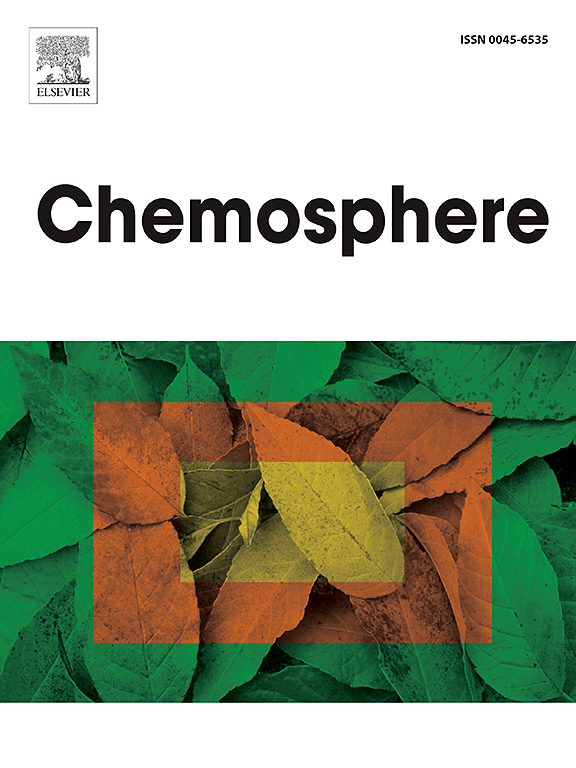重金属浓度表明,西北大西洋不同海龟的污染风险不同
IF 8.1
2区 环境科学与生态学
Q1 ENVIRONMENTAL SCIENCES
引用次数: 0
摘要
重金属污染对全球海洋生物构成越来越大的威胁。由于生物积累,重金属污染的风险对处于高营养水平的大型物种尤其严重,尽管这将根据物种的饮食和觅食地点而有所不同。在这里,我们评估了三种海龟的重金属污染暴露风险:绿海龟(Chelonia mydas),肯普里德利海龟(Lepidochelys kempii)和红海龟(Caretta Caretta)。具体来说,我们收集了美国马萨诸塞州科德角湾冷休克后发现的死龟的皮肤和鳞样本(绿色:n = 8,肯普雷德利:n = 30,红海龟:n = 17)。使用ICP-MS,我们分析了样品中铝、砷、镉、钴、铬、铁、锰、镍、铅、硒、银和锌的浓度。在所有物种中,鳞片中的重金属浓度明显高于皮肤,且变化更大。当比较物种时,PCA分析显示,相对于绿海龟和肯普雷德利海龟,红海龟的金属重金属浓度变化最小,可能是由通才觅食策略驱动的。然而,这三个物种的砷和镉浓度都接近脊椎动物的有毒值,其中红海龟的浓度最高。这些发现强调了在评估海龟重金属暴露风险时考虑种间差异的重要性,并强调了砷和镉是西北大西洋关注的主要污染物。本文章由计算机程序翻译,如有差异,请以英文原文为准。

Heavy metal concentrations suggest pollution risk varies between sea turtle species in the northwest Atlantic Ocean
Heavy metal pollution poses an increasing threat to marine life globally. Due to bioaccumulation, the risks of heavy metal pollution are particularly acute for large species at high trophic levels although this will vary based on a species' diet and foraging location. Here, we assessed exposure risk to heavy metal pollution in three sea turtle species: the green (Chelonia mydas), Kemp's ridley (Lepidochelys kempii), and loggerhead (Caretta caretta) turtles. Specifically, we collected skin and scute samples from deceased turtles found after cold-stunning in Cape Cod Bay, Massachusetts, USA (green: n = 8, Kemp's ridley: n = 30, loggerhead: n = 17). Using ICP-MS, we analyzed samples for aluminum, arsenic, cadmium, cobalt, chromium, iron, manganese, nickel, lead, selenium, silver, and zinc concentrations. Across all species, heavy metal concentrations were predominantly higher and more variable in scute than skin. When comparing species, PCA analysis revealed loggerhead turtles had the least variability in metal heavy concentrations, potentially driven by a generalist foraging strategy, relative to green and Kemp's ridley turtles. Nevertheless, all three species had concentrations of As and Cd near values considered toxic in vertebrates with loggerhead turtles having the highest concentrations. These findings underscore the importance of considering inter-specific differences when assessing the risks of heavy metal exposure in sea turtles and highlight As and Cd as key pollutants of concern in the northwest Atlantic.
求助全文
通过发布文献求助,成功后即可免费获取论文全文。
去求助
来源期刊

Chemosphere
环境科学-环境科学
CiteScore
15.80
自引率
8.00%
发文量
4975
审稿时长
3.4 months
期刊介绍:
Chemosphere, being an international multidisciplinary journal, is dedicated to publishing original communications and review articles on chemicals in the environment. The scope covers a wide range of topics, including the identification, quantification, behavior, fate, toxicology, treatment, and remediation of chemicals in the bio-, hydro-, litho-, and atmosphere, ensuring the broad dissemination of research in this field.
 求助内容:
求助内容: 应助结果提醒方式:
应助结果提醒方式:


